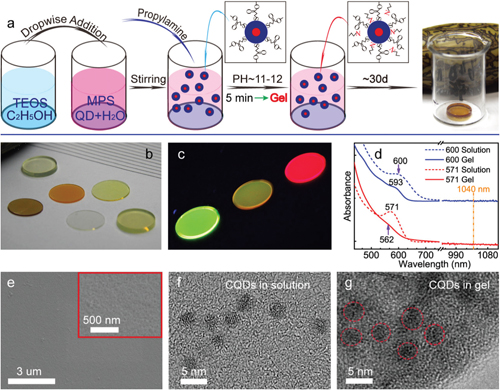
Two-photon (TP) three-dimensional (3D) solid matrices can be applied to high density optical data reading and storage, infrared-pumped visible displays, lasers, etc. Recent experimental and theoretical studies of TP materials mainly focused on the microworld. For practical application, 3D solid matrices that possess stable and tunable TP properties are required.
Colloidal quantum dots (CQDs), a typical zero-dimensional material with a quantized energy structure, have been widely used in optoelectronic fields. Recently, researchers at Shanghai Institute of Optics and Fines Mechanics (SIOM) of Chinese Academy of Sciences have presented a facile method for preparing a homogeneously doped CQD-silica gel glass (CQD-SGG) while maintaining excellent nanoscale TP properties. The study was published in Nanoscale.
Characterization using an open-aperture Z-scan technique shows that the solid matrices exhibited significant TP optical properties with a TP absorption coefficient of (9.41 ± 0.39) × 10−2 cm GW−1 and a third-order nonlinear figure of merit of (7.30 ± 0.30) × 10−14 esu cm.
Researchers also systematically studied the TP behavior of the CQD-SGG, as a function of temperature, in the range of 300 to 523 K. They found that the CQD-SGG can maintain stable TP PL below the synthesis temperature of the CdTe/CdS CQDs.
The results suggest that the TP PL quenching occurs firstly through the formation of carrier trap sites caused by the lattice mismatch. With further increase of the thermal treatment temperature, the ligands on the CQD surfaces are easily detached, leading to substantial surface defects.
This work indicates that such CQD-SGG will provide another promising candidate for investigating TP optical properties and application in novel photoelectronic devices.
This work was supported by the National Natural Science Foundation of China, the Shanghai Rising-star Program, the Youth Innovation Promotion Association of Chinese Academy of Sciences, and the Shanghai Science and Technology Committee.

Figure: (a) Synthesis scheme illustrating the fabrication of the CdTe/CdS CQDs-silica gel glass. (b, c) Photographs of the samples with various concentrations and emission wavelengths under visible room light (b) and 365 nm UV light (c). (d) Absorption spectra of the CQDs in the water solution and silica monoliths. (e) SEM images of the CQDs-silica gel glass. HRTEM images of the CQDs in solution (f) and gel glass (g). (Image by LI Jingzhou)

86-10-68597521 (day)
86-10-68597289 (night)

52 Sanlihe Rd., Xicheng District,
Beijing, China (100864)

